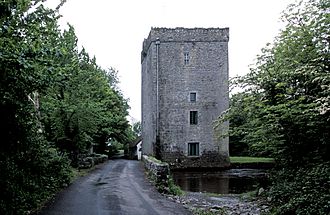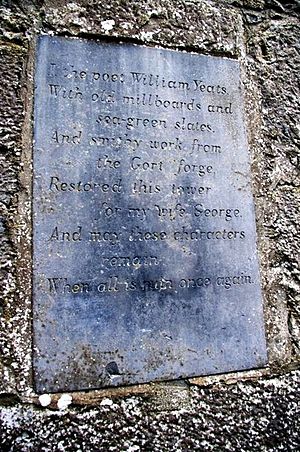Thoor Ballylee facts for kids
Quick facts for kids Thoor Ballylee |
|
|---|---|
 |
|
| General information | |
| Architectural style | Hiberno-Norman tower house |
| Location | County Galway, Ireland |
| Coordinates | 53°06′11″N 8°46′30″W / 53.103°N 8.775°W |
| Construction started | 15th (or 16th) century |
| Completed | 15th (or 16th) century |
| Owner | Earls of Clanrickarde, The Septs de Burgo, William Butler Yeats |
| Design and construction | |
| Architect | The Septs de Burgo |
| Other designers | William Butler Yeats, William A. Scott |
Thoor Ballylee Castle (in Irish, Túr Bhaile Uí Laí) is an old, strong tower house in County Galway, Ireland. It was built by the de Burgo family in the 15th or 16th century. This type of building is called a tower house.
The castle is also known as Yeats' Tower. This is because the famous poet William Butler Yeats once owned and lived there. A well-known poet, Seamus Heaney, even called it "the most important public building in Ireland."
Contents
History of Thoor Ballylee
The castle was built a long time ago, either in the 1400s or 1500s. It was part of the large lands owned by the Earls of Clanricarde. These earls were from the de Burgo family.
A bridge with four arches near the castle was built around 1825. Later, in the early 1900s, the tower became part of the nearby Coole Estate. This estate was the home of Lady Augusta Gregory. She was a very good friend of William Butler Yeats.
Coole House, where Lady Gregory lived, was a meeting place for many important Irish writers. This group helped start the Irish Literary Revival. This was a time when Irish writers created many new and exciting works.
Yeats and His Tower
Thoor Ballylee is often called Yeats’ Tower today. In 1916 or 1917, Yeats bought the tower for a very small amount of money. He loved the quiet countryside and the tower itself.
From 1921 to 1929, Yeats and his family lived there. The tower was very special to him. It felt like a strong, old symbol of his connection to Ireland. Yeats and his architect, William A. Scott, worked to fix up the tower. They put in bigger windows on the lower floors.
Yeats loved the Irish language. He changed the name from "castle" to "Thoor." This is the Irish word for "tower." That's why it's known as Thoor Ballylee. For 12 years, it was Yeats’ summer home. He wrote to a friend, "Everything is so beautiful that to go elsewhere is to leave beauty behind."
The tower inspired Yeats to write many famous poems. These include The Tower and Coole Park and Ballylee.
In 1929, the Yeats family moved out, and the tower became empty and fell into disrepair.
The Tower in Movies and Restoration
In 1951, a scene from the movie The Quiet Man was filmed near Thoor Ballylee. In this scene, actors John Wayne and Maureen O'Hara cross a river right next to the tower.
Later, a woman named Mary Hanley worked hard to save the tower. She started the Kiltartan Society in 1961. Her goal was to get people interested in the history of the area, especially the writers who lived there.
Mary Hanley helped restore Thoor Ballylee. The tower was owned by the Office of Public Works at the time. She convinced the poet Padraic Colum to open the castle again. This happened on June 20, 1965, which was 100 years after Yeats was born.
The tower was opened as Yeats Tower. It looked just like it did when he lived there. It became a museum with some of Yeats' books and furniture. The small cottage next to it became a tea room and shop.
Thoor Ballylee Today
Thoor Ballylee is close to the Streamstown River. Because of this, it sometimes gets flooded. This happened in 1995 and again in 2009/2010. The flooding in 2009 caused a lot of damage to the tower.
For a while, it seemed like there wouldn't be enough money to fix it. But in 2012, work began to restore the tower. A local group called the "Yeats Thoor Ballylee Society" took over the tower in 2014. They wanted to make it a cultural and education center. This was ready for Yeats' 150th birthday in June 2015.
However, in December 2015, a big storm called 'Desmond' hit Ireland. Thoor Ballylee and the cottage were damaged again by floodwaters.
Architecture of the Tower
The tower has four floors. Each floor has one room. A spiral stone staircase connects the rooms. This staircase is built inside the very thick outer wall, which is seven feet wide!
Every floor has a window that looks out over the Streamstown River. This river flows right next to the tower. There is also a small cottage with a thatched roof attached to the tower.
Yeats loved the ground-floor room. He said it was "the pleasantest room I have yet seen." It had a big window looking over the river and a round door leading to the hall. He also admired the winding staircase. He wrote a poem about it, saying it was his "ancestral stair."
There is a special stone tablet on the wall of the tower. It has a poem written by Yeats about his time there:
I, the poet William Yeats,
With old mill boards and sea-green slates,
And smithy work from the Gort forge,
Restored this tower for my wife George.
And may these characters remain
When all is ruin once again.


